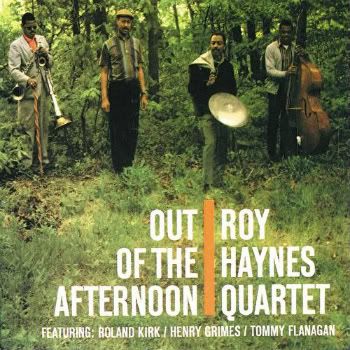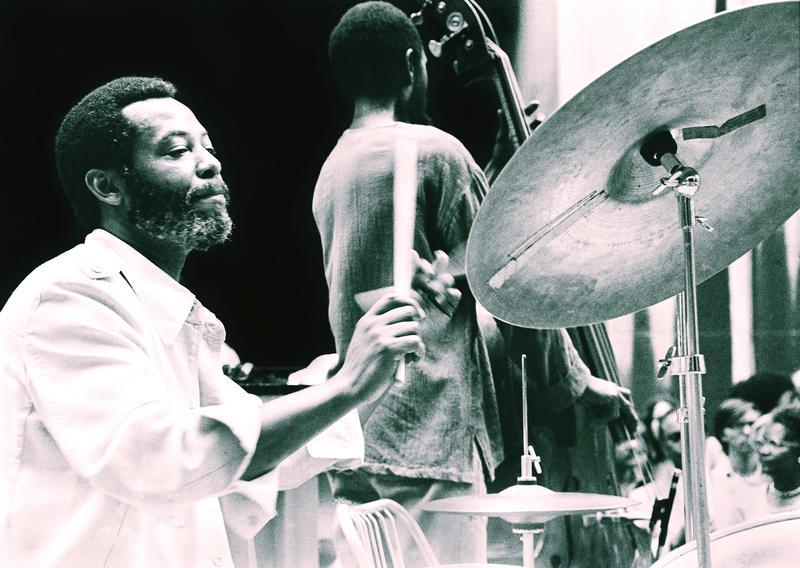It's a really good record IMO. And I for one like Teagarden's singing.I love Teagarden and having Denzil Best and Ken Kersey on the LP really makes that interesting!!
You are using an out of date browser. It may not display this or other websites correctly.
You should upgrade or use an alternative browser.
You should upgrade or use an alternative browser.
Today's JAZZ playlist
- Thread starter savv
- Start date
darkblue94
The Devil made me do it.
darkblue94
The Devil made me do it.
KrisM
Lunatic Member
I've got my old Boba Fett figurine that has bounced from stereo to stereo over the years.I had to laugh when I saw the Blue Meanie and George - So I'm not the only one who collects foolish stuff like that....
The garage system has a bobble head Jesus on one of the speakers, lol.
Beau Geste
Italia
bluemonkey
Well-Known Member

Roy Haynes Quartet: Out Of The Afternoon
fuzzywobbles
Lunatic Member

Bought a sizable stack of assorted vinyl from a guy at an outdoor Flea Market back a month or two. Was talking jazz with him and he said he didn't bring much jazz as it doesn't sell well for him. I offered to remedy that situation for him next time. Well about a month or two with the timing not working later, and we finally connected today. Picked up a couple dozen nice jazz titles for a very nice price. Starting off with this Hubbard, and likely spinning the new arrivals for the foreseeable future.
The guys personal collection was one of the best I have ever seen, in person or on the web. Hes digs jazz, but is more into the old psychedelic, garage and blues stuff. I saw stuff I have only seen pictures of and other stuff that looked great that I have never even heard of...
Last edited:
fuzzywobbles
Lunatic Member
Beau Geste
Italia
fuzzywobbles
Lunatic Member
Thank you!
The first LP, "Breakin' It Up", with William Austin on bass, and Frank Gant on drums. And then the great album Barry and Sonny Stitt made with the same rhythm section..
fuzzywobbles
Lunatic Member
fuzzywobbles
Lunatic Member
Ben Riley, a Jazz Drummer Who Made Accompaniment His Art, Has Died at 84
By Nate Chinen • 2 hours ago
TwitterFacebookGoogle+
Ben Riley, playing with the Heath Brothers at Rockefeller Center, in June 1977
Tom Marcello / Flickr
Ben Riley, a subtle and versatile jazz drummer best known for his affiliation with Thelonious Monk in the 1960s and Kenny Barron, one of Monk’s pianistic heirs, in all the years since, died on Saturday at Good Samaritan Hospital in West Islip, New York. He was 84.
His death was confirmed by his daughter Kim, who said the cause of death is not yet known.
Riley enjoyed a six-decade career in jazz, playing on more than 300 albums. Along with Monk and Barron, he backed the pianists Andrew Hill and Abdullah Ibrahim, the tenor saxophonists Johnny Griffin and Stan Getz, and many others.
His drumming was noted for understatement, and for a slightly skewed rhythmic conception that could keep the listener off balance. If these seem contradictory, it was perhaps Riley’s greatest gift that he reconciled them.
“I came up in an era of accompaniment,” he told Modern Drummer magazine in 2005. “I enjoy that more than soloing, because each person I’ve worked with has had different attitudes, songs, and styles of playing.” He added: “I never come on a job thinking, ‘I’m going to play this or play that.’ I wait to see what they’re going to do and then fit into that picture.”
 <img src="http://wbgo.org/sites/wbgo/files/styles/default/public/201711/benriley17.jpg" alt="Ben Riley at the Village Vanguard, Sept. 2004">
<img src="http://wbgo.org/sites/wbgo/files/styles/default/public/201711/benriley17.jpg" alt="Ben Riley at the Village Vanguard, Sept. 2004">
Ben Riley at the Village Vanguard, Sept. 2004
Credit Paul LaRaia
In fact, Riley’s love of accompaniment was so pronounced that he recorded only three times as a bandleader, making his name-above-the title debut at age 60, with called Weaver of Dreams, featuring bassist Buster Williams and saxophonist Ralph Moore.
Prior to joining Monk’s band, Riley’s most widely acclaimed work was with tenor saxophonist Sonny Rollins, on his 1962 album The Bridge. Riley’s playing on this landmark — Rollins’ first artistic statement since returning from a sabbatical, which he spent practicing almost daily on the Williamsburg Bridge — affirms that sensitivity need not mean the loss of rhythmic oomph.
During Rollins’ solo on “John S.,” he swings hard on his ride cymbal while playing snare-drum accents so softly that they almost sound like brushwork, right up until his solo breaks.
Some of Riley’s more eccentric choices as a drummer were surfacing by the time of his 1960 recordings with Johnny Griffin, but they didn’t come fully to the fore until he joined Monk, a rhythmic eccentric in his own right, in 1964. He made his first appearance on It’s Monk’s Time, having been hired without previously playing or even rehearsing with the band.
But he works with relish and understanding, even on new tunes like “Brake’s Sake.” Riley seems to know instinctively where the accents need to be, hitting them on the head with Monk and saxophonist Charlie Rouse, while slipping in some of his own devices, especially during Rouse’s solo.
Benjamin Alexander Riley, Jr. was born on July 17, 1933 in Savannah, Georgia, and grew up in New York City. Interested in the drums from toddlerhood, he learned from the many musicians who lived or worked near his neighborhood, in the Sugar Hill section of Harlem. His most important early teacher was a little-known drummer named Phil Wright.
But he locked in on a prominent bebop player as his primary influence. “The first time I heard Kenny Clarke… ‘Uh-oh,’ I said, ‘I think that’s it,’” Riley told Ted Panken in 1994. “I love the way he accompanied, and I loved the subtleties that he brought to the table.”
Riley’s early career, after his discharge from the Army in the mid-1950s, found him accompanying Getz, pianist Randy Weston and saxophonist Sonny Stitt. He recorded with Griffin and another rough-edged saxophonist, Eddie “Lockjaw” Davis.
Riley’s association with Barron began in the 1970s and continued for decades, including lengthy collaborations first in bassist Ron Carter’s quartet, and then in the Monk tribute band Sphere. Their musical relationship was deeply empathic: on this 1978 recording with Buster Williams, hear how Riley anticipates almost every space and shift in tempo or dynamics in Barron’s solo.
In addition to his daughter Kim, Riley is survived by his wife, Inez Riley; another daughter, Gina; two sons, Corey and Jason Riley; nine grandchildren; 17 great-grandchildren; and one great-great-grandchild.
Riley’s final years were spent in a nursing home. According to his daughter, he was still making music. “There was another musician in there with him, and every week my father would play with him,” Kim said. “He didn’t have drums, but he would beat on the table, or chairs, or whatever. Playing all the way to the end.”
By Nate Chinen • 2 hours ago
TwitterFacebookGoogle+

Ben Riley, playing with the Heath Brothers at Rockefeller Center, in June 1977
Tom Marcello / Flickr
Ben Riley, a subtle and versatile jazz drummer best known for his affiliation with Thelonious Monk in the 1960s and Kenny Barron, one of Monk’s pianistic heirs, in all the years since, died on Saturday at Good Samaritan Hospital in West Islip, New York. He was 84.
His death was confirmed by his daughter Kim, who said the cause of death is not yet known.
Riley enjoyed a six-decade career in jazz, playing on more than 300 albums. Along with Monk and Barron, he backed the pianists Andrew Hill and Abdullah Ibrahim, the tenor saxophonists Johnny Griffin and Stan Getz, and many others.
His drumming was noted for understatement, and for a slightly skewed rhythmic conception that could keep the listener off balance. If these seem contradictory, it was perhaps Riley’s greatest gift that he reconciled them.
“I came up in an era of accompaniment,” he told Modern Drummer magazine in 2005. “I enjoy that more than soloing, because each person I’ve worked with has had different attitudes, songs, and styles of playing.” He added: “I never come on a job thinking, ‘I’m going to play this or play that.’ I wait to see what they’re going to do and then fit into that picture.”
 <img src="http://wbgo.org/sites/wbgo/files/styles/default/public/201711/benriley17.jpg" alt="Ben Riley at the Village Vanguard, Sept. 2004">
<img src="http://wbgo.org/sites/wbgo/files/styles/default/public/201711/benriley17.jpg" alt="Ben Riley at the Village Vanguard, Sept. 2004"> Ben Riley at the Village Vanguard, Sept. 2004
Credit Paul LaRaia
In fact, Riley’s love of accompaniment was so pronounced that he recorded only three times as a bandleader, making his name-above-the title debut at age 60, with called Weaver of Dreams, featuring bassist Buster Williams and saxophonist Ralph Moore.
Prior to joining Monk’s band, Riley’s most widely acclaimed work was with tenor saxophonist Sonny Rollins, on his 1962 album The Bridge. Riley’s playing on this landmark — Rollins’ first artistic statement since returning from a sabbatical, which he spent practicing almost daily on the Williamsburg Bridge — affirms that sensitivity need not mean the loss of rhythmic oomph.
During Rollins’ solo on “John S.,” he swings hard on his ride cymbal while playing snare-drum accents so softly that they almost sound like brushwork, right up until his solo breaks.
Some of Riley’s more eccentric choices as a drummer were surfacing by the time of his 1960 recordings with Johnny Griffin, but they didn’t come fully to the fore until he joined Monk, a rhythmic eccentric in his own right, in 1964. He made his first appearance on It’s Monk’s Time, having been hired without previously playing or even rehearsing with the band.
But he works with relish and understanding, even on new tunes like “Brake’s Sake.” Riley seems to know instinctively where the accents need to be, hitting them on the head with Monk and saxophonist Charlie Rouse, while slipping in some of his own devices, especially during Rouse’s solo.
Benjamin Alexander Riley, Jr. was born on July 17, 1933 in Savannah, Georgia, and grew up in New York City. Interested in the drums from toddlerhood, he learned from the many musicians who lived or worked near his neighborhood, in the Sugar Hill section of Harlem. His most important early teacher was a little-known drummer named Phil Wright.
But he locked in on a prominent bebop player as his primary influence. “The first time I heard Kenny Clarke… ‘Uh-oh,’ I said, ‘I think that’s it,’” Riley told Ted Panken in 1994. “I love the way he accompanied, and I loved the subtleties that he brought to the table.”
Riley’s early career, after his discharge from the Army in the mid-1950s, found him accompanying Getz, pianist Randy Weston and saxophonist Sonny Stitt. He recorded with Griffin and another rough-edged saxophonist, Eddie “Lockjaw” Davis.
Riley’s association with Barron began in the 1970s and continued for decades, including lengthy collaborations first in bassist Ron Carter’s quartet, and then in the Monk tribute band Sphere. Their musical relationship was deeply empathic: on this 1978 recording with Buster Williams, hear how Riley anticipates almost every space and shift in tempo or dynamics in Barron’s solo.
In addition to his daughter Kim, Riley is survived by his wife, Inez Riley; another daughter, Gina; two sons, Corey and Jason Riley; nine grandchildren; 17 great-grandchildren; and one great-great-grandchild.
Riley’s final years were spent in a nursing home. According to his daughter, he was still making music. “There was another musician in there with him, and every week my father would play with him,” Kim said. “He didn’t have drums, but he would beat on the table, or chairs, or whatever. Playing all the way to the end.”
bluemonkey
Well-Known Member

Ruby Braff: Music For The Still Of The Night
fuzzywobbles
Lunatic Member
E.Auer
Super Member
I had to laugh when I saw the Blue Meanie and George - So I'm not the only one who collects foolish stuff like that....

Eric













